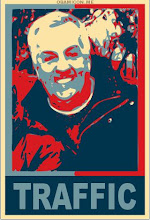December 30, 2008, 7:40 am — Updated: 12:42 pm -->
By Kate Galbraith Copyright 2008 The New York Times Company

More drivers in more states are encountering signs like this one. (Photo: Laura Pedrick for The New York Times)
From Minnesota to Florida, drivers grumble that roundabouts are confusing and dangerous.
But the Insurance Institute of Highway Safety says that modern roundabouts — which have proliferated in this country in recent years — are not only far safer than regular intersections, they are also more fuel efficient. Drivers use about 30 percent less gas when using a roundabout compared with a traffic signal, according to the Institute, because they don’t necessarily have to stop and idle.
Modern roundabouts differ from older traffic circles — like Dupont Circle in Washington or Grand Army Plaza in New York — in a few ways. The new ones are smaller, and also have sharper angles, so that drivers are forced to enter more slowly and are supposed to yield rather than merge. This, at least in theory, makes them safer, though drivers do not always know the rules.Still, states are rushing to build them — not least because roundabouts, with no traffic signals to maintain, are comparatively cheap.
Three years ago Arizona had two roundabouts. Now it has around 17, with 23 more under construction, according to Tim Tait, a spokesman for Arizona’s transportation department. In New York, just 16 modern roundabouts were added between 2001 and 2005; since early 2006, 37 more have been built, according to the New York Department of Transportation.
Some businesses near busy intersections are clamoring for roundabouts. In the town of Rutherford, in the Napa Valley, some wineries off a busy highway are lobbying for a roundabout to give visitors easier access.
“While a traffic signal is likely to operate satisfactorily, a roundabout would be more in keeping with the rural nature of the area,” a proposal for the project reads, “and would be expected to operate substantially more efficiently than a signal for extended periods of the day.”



No comments:
Post a Comment